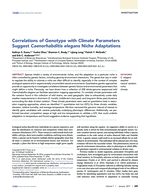Correlations of geneotype with climate parameters suggest Caenorhabditis elegans niche adaptations
Evans et al. 2016
Evans KS, Zhao Y, Brady SC, Long L, McGrath PT, Andersen EC
(2016 Nov 18) G3 [ DOI | Pubmed ]
Abstract
Species inhabit a variety of environmental niches, and the adaptation to a particular niche is often controlled by genetic factors, including gene-by-environment interactions. The genes that vary in order to regulate the ability to colonize a niche are often difficult to identify, especially in the context of complex ecological systems and in experimentally uncontrolled natural environments. Quantitative genetic approaches provide an opportunity to investigate correlations between genetic factors and environmental parameters that might define a niche. Previously, we have shown how a collection of 208 whole-genome sequenced wild Caenorhabditis elegans can facilitate association mapping approaches. To correlate climate parameters with the variation found in this collection of wild strains, we used geographic data to exhaustively curate daily weather measurements in short-term (3 month), middle-term (one year), and long-term (three year) durations surrounding the date of strain isolation. These climate parameters were used as quantitative traits in association mapping approaches, where we identified 11 quantitative trait loci (QTL) for three climatic variables: elevation, relative humidity, and average temperature. We then narrowed the genomic interval of interest to identify gene candidates with variants potentially underlying phenotypic differences. Additionally, we performed two-strain competition assays at high and low temperatures to validate a QTL that could underlie adaptation to temperature and found suggestive evidence supporting that hypothesis.
